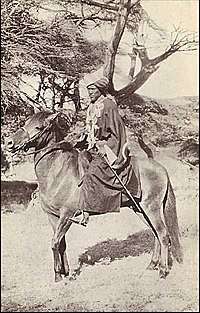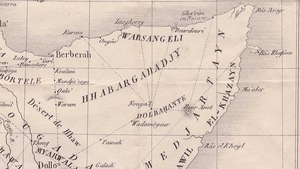Garhajis
The Garhajis (Somali: Garxajis, Arabic: غرحجس, Ismail (Garhajis) Shiekh Ishaaq ibn Ahmad) is a major sub-clan of the wider Isaaq clan. They are the traditional holders of the Isaaq Sultanate since the 18th century. Its members form a part of the Habar Magaadle confederation, and they contstitute the largest sub-clan of the Isaaq.[1][2][3][4] The Garhajis are divided into two major sub-clans, the Habar Yunis and Eidagale.[5][6] They are traditionally nomadic pastoralists, merchants and skilled poets. One of the earliest mentions of the Garhajis in Western literature was in the Journal of the Royal Geographical Society of London in 1848, where they are described as a powerful and warlike clan with an abundance of livestock reserves.[7]
Garhajis الغرحجس | |
|---|---|
| Regions with significant populations | |
| Languages | |
| Somali, Arabic | |
| Religion | |
| Islam (Sunni) | |
| Related ethnic groups | |
| Arap, Ayub, Habr Awal, Habr Je'lo, and other Isaaq groups |
Distribution
The Garhajis inhabit the western Togdheer, eastern Maroodi Jeex, southern Sahil, northern Sool and central Sanaag regions of Somaliland. They also inhabit the Degehbur, Wardheer and Aware zones in the Haud region of Ethiopia. They also have a large settlement in Kenya where they are known as a constituent segment of the Isahakia community.[8][9]
History
Lineage
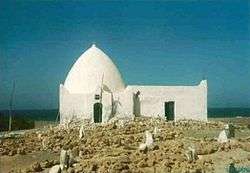
Sheikh Ishaaq Bin Ahmed was one of the Arabian scholars that crossed the sea from Arabia to the Horn of Africa to spread Islam around 12th to 13th century. He is said to have been descended from Prophet Mohammed's daughter Fatimah. Hence the Sheikh belonged to the Ashraf or Sada, titles given to the descendants of the prophet. It is said he married two local women in Somalia that left him eight sons, one of them being Ismail (Garhajis).[10]
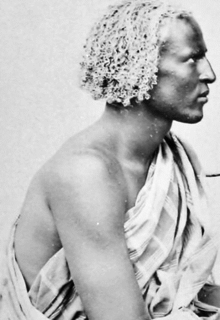
Medieval period (Conquest of Abyssinia)
Historically the Garhajis took part in the conquest of Abyssinia and were part of the Adal Sultanate and are mentioned in the book Futuh Al-Habash (Conquest of Abyssinia) as the Habar Magaadle along with the Habar Awal, Arap and Ayub clans. The Habar Magaadle are known for producing a historical figure known as Ahmad Gurey bin Husain who was the right-hand man of Ahmad ibn Ibrahim al-Ghazi.[11]
Descriptions of the Garhajis by European travellers in the 1800s
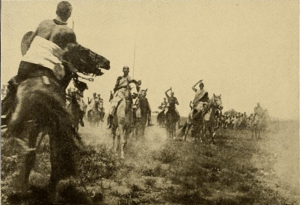
Several early European travellers gave descriptions of the Garhajis clan during their travels through Somaliland in the 1800s and early 1900s. The Garhajis were described as being nomads who had a reputation of being fine warriors and who were very skilled equestrians, and were noted to be among the best horsemen and in possession of the best breed of Horses among the Somali.
Description of the Garhajis by C.J Cruttenden in the 1840s:
The Haber Gerhajis, the eldest branch of the three tribes of Ishaak, reside chiefly in the mountains to the south of berbera, whence they extend to the country of Ogahden. They are a powerful and warlike tribe, numbering many horses in addition to their flocks and herds.[12]
Edward Standford FRGS, 1885:
The Haber-Gerhajis tribe had formerly been under one Sultan [Hirsi Aman] and were very powerful, making frequent raids into Ogadayn, but on his death, two cousins, Awad and Nur, divided the country between them.[13]
Explorer Frank Linsly James, a guest of Sultan Awad (Cawad) Diiriye Sugulleh during his visit to Somaliland in 1884, described a performance he witnessed by Habr Yunis Horsemen at Burao's Togdheer River.
During our stay at Burao, the Sultan collected a great many of his people together, and twice entertained us with some well-executed and characteristic evolutions on horseback. On the first occasion some forty mounted men were collected in the Tug before our zariba; but this did not satisfy the Sultan, and he arranged a second "fantasia," in which fully two hundred warriors were engaged. It was the best and most characteristic thing of the kind I had ever seen. A procession was first formed in the river's bed, and on a given signal all dashed off, brandishing their spears and shields. Dressed in tobes of many colours, and sitting loosely on their gaily-caparisoned horses, they engaged in mimic contest with spear and shield, reining their horses upon their haunches when at full gallop, and with wild shouts flinging their spears into the air. Each warrior carried a short-handled whip with a broad raw hide thong, and with it lashed his steed unmercifully. Some of the riders went through regular circus feats, leaping from their horses when at full gallop, picking up objects thrown on the ground, and then remounting. After this had continued for some time they would gallop close to our zariba, and reining up, shout "Mort, mort" ("Welcome, welcome"), to which we replied, "Kul liban" ("Thanks").[14]
D. G. Elliot commenting on the Garhajis during his visit to the Haud in 1896:
The Haber Yunis tribe, one of the most powerful in this part of Africa, and which could place several thousand warriors in the field. Like all of the natives of Somaliland they are nomads, wandering from place to place in search of water and pasture for their flocks and herds...The Habr Yunis warriors commenced to give an exhibition of their horsemanship, riding away singly or in pairs advancing to the attack, thrusting with the spear and guarding with the shield on which the point of the spear was received. They had fine horses, much superior to our own, and in the best condition.[15]
According to military historian Roy Irons, Major J. G. Beresford of the 7th Hussars Cavalry regiment also attested to the skill of Habar Yunis horsemen.[16]
"Of the Somali tribal horse, Major J.G beresford reported that the Habr Yunis, Dolbahanta and Ba Idris were the best." Roy Irons, Churchill and the Mad Mullah.[17]
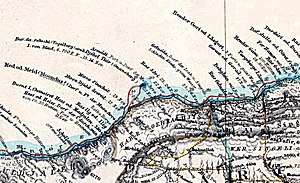
Richard Francis Burton the British explorer, gave a description of the Garhajis during his visit to Somaliland in 1855:
The Habr Gerhajis, or eldest branch of the sons of Ishak, inhabit the Ghauts behind Berberah, whence they extend for several days' march to- wards Ogadayn, the southern region. This tribe is divided into a multitude of clans. The Ismail Arrah supply the Sultan, a nominal chief like the Eesa Ugaz ; they extend from Makhar to the south of Gulays, number about 15,000, shields and are subdivided into three septs. The Musa Arrah hold the land between Gulays and the seats of the Mijjarthayn and Warsangeli tribes on the windward coast. The Ishak Arrah count 5000 or 6000 shields, and inhabit the Gulays Range.[18]
Shermarke Ali, governor of Berbera, Zeila and Tajoura (1833-1861)
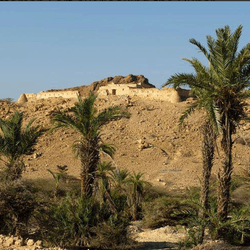
The Habr Yunis exercised real power over Zeila and its adjacent regions and had established themselves as a coastal power, with Sharmarke Ali Saleh (Musa Arreh) solidifying and consolidating his power in governing Zeila, Berbera and Tadjoura. In 1841 Sharmarke with 50 Matchlock men, 2 cannons and an army of mounted spearmen managed to invade Zeila and depose its Arab Governor, Mohammed Al Barr. Sharmarke used the canons to fire at the city walls which frightened Al Barr's followers and caused them to flee. Sharmarke succeeded Al Barr as the ruler of Zeila and its dependencies.[19][20] Sharmarke's governorship had an instant effect on the city, as he maneuvered to monopolize as much of the regional trade as possible, with his sights set as far as Harar and the Ogaden.[21] Having secured Zeila, in 1845 Sharmarke moved on to Berbera which at the time was experiencing instability as a result of a war between the Habr Awal Reer Yunis Nur and Reer Ahmed Nur sub-clans over the control of Berbera's trade. Sharmarke took advantage of this rivalry and supported the Reer Ahmed Nuh who had since been expelled from Berbera. Sharmarke took over Berbera and built four Martello towers in the vicinity of the town and garrisoned them with 30 Matchlock men. A war ensued with in the city as Reer Yunis Nuh tried gain a foothold within Berbera, the Reer Yunis Nuh were no match for Sharmarke and his modern weapons and thus failed. The Reer Yunis Nuh were expelled and moved to Bulhar [22] Sharmarke's influence was not limited to the coast as he had many allies in the interior of the Somali country and even further in Abbyssinia. Among his allies were the Kings of Shewa. When there was tension between the Amir of Harar Abu Bakr II ibn `Abd al-Munan and Sharmarke, as a result of the Amir arresting one of his agents in Harar, Sharmarke persuaded the son of Sahle Selassie, the King of Shewa, to imprison on his behalf about 300 citizens of Harar then resident in Shewa, for a length of two years.[23]
1870s -1940s (Rayyad Wars)
During this period the Garhajis were fighting an expansionist war against the Ogaden clans and gained much new territory in the Haud region. These battles are today known as the Rayyad or Guba Wars. It was a volatile era that gave birth to some of the best known Somali poetry.
In 1874 German Explorer G.A Haggenmacher witnessed the aftermath of a battle between Habr Yunis and Ogaden. He wrote:
The Habr Yunis had many wounded, but were also extremely rich in loot, the estimated number of loot was at least 10,000 camels.[24]
In 1877 the Garhajis under the leadership of Sultan Hersi Aman conquered Daroor and subjugated the Haroun sub-clan of the Ogaden, during the battle they captured and subsequently executed their Sultan.[25] The Habr Yunis then proceeded to expand into Doolo region and took control of watering wells, grazing land and looted thousands of camels from the Cabdille, Makahil, Ali and Haroun sub clans of the Ogaden, forcing them to leave their homeland and flee south to Hiiraan. This particular series of conquests was what initiated the famous chains of poems known as Guba in which Ali Dhuh a Daarood poet laments, and berates the Ogadenis for losing so much land and exchanges heated poems with the Ogaden and Habr Yunis.[26][27]
Historian Siegbert Uhlig commenting on the Guba poem writes the following:
From a historical point of view Ali dhuhs poem explicitly details the large gains in traditionally Ogaden territory and wells, and the looting of Ogaden camels by the Isaq. He details the scatterring of the Ogaden clan, their forced migration southwards seeking refuge in the feverish river valleys, and even turning to hunting and farming- measures that were again considered very shameful usually only undertaken by slaves and low-caste Somalis and utterly demeaning for the once great pastoral Ogaden clan. The Ogaden, Ali recounts, have been forced to accept refuge with the clans that defeated them, especially the Habr Yunis, and cannot take revenge. The Isaq are portrayed as particularly callous and shameful in the way they parade looted Ogaden camels in front of their previous owners. Even in translation it is a very evocative poem".[26]
The Habr Yunis advance into Ogaden territory was eventually halted by the intervention of the British protectrate authorities with assistance from the Ethiopian Empire, who considered the Ogaden their subjects and whose safety was their priority. In one incident the Habar Yunis looted 1330 camels from the Ogaden, but were pressured by the British and the Ethiopians to return the camels to their previous owners. The Habr Yunis obliged and promised to desist in their raids, but despite their promise they continued to successfully raid the Ogadens unhindered up until the British ceded the Haud to Ethiopia.[28][29][30]
Dervish period
The Garhajis clan played a prominent role in the inception of the Dervish movement and its subsequent struggle against the British Empire. Among the prominent members of the Dervish was the Sultan of the Habar Yunis, Nur Ahmed Aman, whose letter to Mohammed Abdullah Hassan initiated the Dervish rebillion. Nur was the principle agitator that rallied the dervish behind his anti-French Catholic Mission campaign that would become the cause of the dervish uprise.[31]
The news of the incident that sparked the Dervish rebellion and the 21 years disturbance according to the consul-general James Hayes Sadler was either spread or as he alleged was concocted by Sultan Nur of the Habr Yunis. The incident in question was that of a group of Somali children that were converted to Christianity and adopted by the French Catholic Mission at Berbera in 1899. Whether Sultan Nur experienced the incident first hand or whether he was told of it is not clear but what is known is that he propagated the incident in the Tariqa at Kob Fardod in June 1899 precipitating the religious rebellion that later morphed into the Somali Dervish.[32]
Sultan Nur leading his Dervish clansmen participated in numerous battles against the British. These confrontations took place at Samala, Ferdidin, Erigo, Daratoleh and Gumburu. In 1899 Sultan Nur was among the top five (Mohammed Abdullah Hassan, Haji Sudi, Deria Arrale and Deria Gure) wanted leaders of the movement.[33]
Before dispatching forces to face the Dervish at Samala, Consul-General Hayes Salder made the following instructions to the overall commander of the forces Eric John Eagles Swayne:
"In the unlikely event of the: Mullah offering to surrender, in his case and that of the Following: Haji Sudi, Deria Arale, Deria Gure Only an unconditional surrender should be accepted no guarantee of any kind to future treatment been given. Sultan Nur the , sultan of the Habr Yunis, may be guaranteed his life." J. Hayes-Sadler, His Britannic Majesty's Consul-General, Somali Coast Protectorate. Aden April 11, 1901."[34]
Despite confronting Nur in many battles the British failed in their mission to capture or kill him. Gabriel Ferrand, the Vice-Council of France following these events observed that:
"Neither the Mahdi nor his chief advisor Ahmed Warsama, better known under the name Haji Sudi, nor the Sultan Nur, leader of the Habr Younis clan were killed or captured. The optimism of Colonel Sadler and Lieutenant-Colonel Swayne in the latest reports relating to military operations is inexplicable." [35]
In 1904 the Dervish state entered into talks with Italy and both parties agreed to sign a peace treaty, this treaty came to be known as the Pestalozza agreement.[36] Sultan Nur and his brother Geele Ahmed were among the signatories of the Pestalozza agreement between Italy and the Dervish state in 1905. In the original Arabic document the following signatures appear - sultan Nur Ahmed (the chief dervish sultan) and his brother Geele Ahmed (Kila Ahmed), Ugas Diria Arabe and Ugas Issa Farek.[37][38]
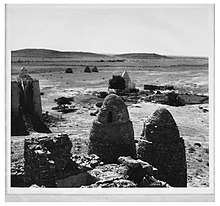
The last intelligence report mention of Sultan Nur in the Italian archives was in 1907.[39] After the death of sultan Nur 1907/1908 in the dervish camp at Taleh his son Dolal sultan Nur ascended the sultanate in the dervish camp.[40]
Sultan Nur was buried by his dervish in a large domed tomb in Taleh, his tomb predated the later dervish forts. His white tomb in the dervish capital is a testimony to his contribution to the movement. Few dervish founders are commemorated in Taleh, numbering only four.[41]
William Archibald Macfadyen, a British geologist and the only scholar to study the structures of Taleh fort, mentioned the handful of tombs constructed by the dervish for their leaders and gave a detailed description of the tombs in 1931. In his article Macfayden only identified Sultan Nur's tomb by name out of the four dervish entombed in Taleh:
"South of the main cave-well is the considerable tomb of Abdullah Hasan
senior, well plastered inside and out; it is now said to be empty. Adjoining this on the west is a walled garden with massive gateway and guard-house; the rest of the wall is not more than 5 feet high and plastered. There are still odd bushes and signs of cultivation to be seen, but the comparatively deep well in the middle is dry. To the east lies a row of four tombs. The most northerly is that of one Soldan Nur of the Habr Yunis tribe; the next two, neither being plastered. and the first with the top left unfinished, are those of Hawiya notables whose names my Somalis did not know. The most southerly tomb is that of a man of the Habr Jaalo tribe. The isolated tomb still farther east is that of 'AbdullahHasan's mother. All the tombs are provided with narrow but very massive wooden doors, swinging about vertical extensions from top and base
of one side."[41]
The Habr Yunis sub-clans that joined the Dervish were the Musa Ismail (Gadwein), the Sa'ad Yunis and sections of Sultan Nur's own sub-clan, the Hersi Osman. The Gadwein Dervishes who were located in coastal Sanaag and the towns of Midisho and Jidali created complications for the Warsengeli Sultanate, who they regularly raided. The Warsengeli who were at that time allied with the British called for their assistance. Consequently, in 1912 the British sent the warship HMS Philomel and shelled the Gadwein Dervishes, pushing them from the coast and inland towards Las Dureh.[42][43][44][45] The Dervish forces of Sanaag were supplied with arms and munitions by two Habr Yunis men of the Musa Arreh clan, namely, Haji Hirsi of Maydh and Bulhan Ali, they both operated with in Yemen, the former being stationed at Mukalla and the latter at Aden. Both were Ottoman agents and were accused by Sultan Mohamoud Ali Shire of instigating attacks on Las Khorey.[46] Among the prominent Sa'ad Yunis Dervish was Haji Yusuf, popularly known as Taminlaaye, he was in charge of the Sanaag division of the Dervish army. The British put a bounty on his head and his name appeared in the 1919 most wanted Dervish list published by the British, alongside him appeared the names of other Isaaq clan members such as Haji Sudi, Ibrahim Boghol, Ibraahim Gioode and Deria Arale.[47]
Though some sections of the Garhajis supported the Dervish movement at the time of its inception, like many other Dervish allied clans they became disillusioned with the movement towards the end. After the Bombing campaign of the Taleh fort and the Dervish retreat into Ethiopia, Tribal Chief Haji Mohammad Bullaleh (Haji the Hyena) who hailed from the Rer Ainanshe clan of the Habr Yunis, commanded a 3000 strong army that consisted of Habr Yunis, Habr Je'lo and Dhulbahante warriors and pursued the fleeing Dervishes. They attacked Muhammad Abdallah Hassan and his army in the Ogaden region and swiftly defeated them, causing Muhammad to flee to the town of Imi. Haji and his army looted 60,000 livestock and 700 rifles from the dervishes, which dealt a severe blow to them economically, a blow from which they did not recover.[48][49][45][50] The Garhajis, especially the Habr Yunis, had a hand in the birth and the eventual demise of the Dervish state.
Burao Tax Revolt

Sections of the Habr Yunis once again clashed with the British in 1922 after a tax was imposed upon them at Burao. This resulted in the Baho Ainanshe and Rer Sugulleh sub-clans revolting in opposition to the tax and clashing with other sections of the Habr Yunis and the British colonial government. This resulted in a shoot out in which Captain Allan Gibb, a Dervish war veteran, was shot and killed. The British as retaliation burnt down Burao and requested from Sir Winston Churchill, then Secretary of State for the Colonies, to send troops from Aden and Airplane bombers in order to bomb the wells and livestock of the Rer Ainanshe clans and quell any further rebellion.[51] After the killing of Gibb all Europeans entered the Burao fort, which at the time was occupied by the Native Somali B Company of the Somaliland Camel Corps. The Hargeisa Camel Corps was wired and informed of the incident and ordered to send troops to Burao. The Indian Sepoys having been sent back to the sub-continent forced the Government to rely on the Somali B company, but when ordered to open fire on the hostile Habr Yunis clansmen, they declined. The British had to resort to sending Indian troops from Aden as they could not trust the native Somalis. Instead The B company was tasked with collecting the fine imposed on the Rer Ainanshe. B company was eventually disbanded and replaced with the more obedient Yao Askaris from the 1st King's African Rifles.[52][53][54][55]
Telegram from Sir Geoffrey Archer, Governor of British Somaliland to Sir Winston Churchill the Secretary of State for the Colonies:
I deeply regret to inform that during an affray at Burao yesterday between Rer Sugulleh and Akils of other tribes Captain Gibb was shot dead. Having called out Camel corps company to quell the disturbance, he went forward himself with his interperter, whereupon fire opened on him by some Rer segulleh riflemen and he was instantly killed..Miscreants then dissapered under the cover of darkness. In order to meet the situation created by the Murder of Gibb, we require two aeroplanes for about fourteen days. I have arranged with resident, Aden, for these. And made formal application, which please confirm. It is proposed they fly via Perim, confining sea crossing to 12 miles. We propose to inflict fine of 2,500 camels on implicated sections, who are practically isolated and demand surrender of man who killed Gibbs. He is known. Fine to be doubled in failure to comply with latter conditions and aeroplanes to be used to bomb stock on grazing grounds.[56]
Sir Winston Churchill reporting on the Burao incident at the House of Commons:
On 25th February the Governor of Somaliland telegraphed that an affray between tribesmen had taken place at Burao on the previous day, in the course of which Captain Allan Gibb, D.S.O., D.C.M., the District Commissioner at Burao, had been shot dead. Captain Gibb had advanced with his interpreter to quell the disturbance, when 1954 fire was opened upon him by some riflemen, and he was instantly killed. The murderers escaped under cover of falling darkness. Captain Gibb was an officer of long and valued service in Somaliland, whose loss I deeply regret. From the information available, his murder does not appear to have been premeditated, but it inevitably had a disturbing effect upon the surrounding tribes, and immediate dispositions of troops became necessary in order to ensure the apprehension and punishment of those responsible for the murder. On 27th February the Governor telegraphed that, in order to meet the situation which had arisen, he required two aeroplanes for purposes of demonstration, and suggested that two aeroplanes from the Royal Air Force Detachment at Aden should fly over to Berber a from Aden. He also telegraphed that in certain circumstances it might become necessary to ask for reinforcements of troops to be sent to the Protectorate.[57]
Sir Geoffrey Archer reporting on situation after RAF mission:
Effect of Areoplane demonstration on country has been electrical, and its unlikely now that i shall require troops from Aden as an emergency measure..One section of Rer Ainanshe has surrenderd 450 camels. Fine will be completed in a few days. It is realised that the surest way to effect capture is to mark them down and arrest them ourselves. With this end in view names have not been divulged.[55]
Bomber planes were flown over Burao and the Haud, while watering wells that were essential to the Habr Yunis nomads were blocked by the Camel corps. The Rer Ainanshe clans isolated and without support eventually acquiesced, agreeing to pay the fine but they refused to identify and apprehend the accused individuals. Most of the men responsible for Gibb's shooting were never caught and evaded punishment. Captain Gibb was among the most respected and valued British Officers in British Somaliland, he fought during the Dervish wars and operated a Maxim Gun, and was credited with capturing Taleh fort in 1920.[58][55]
Somali civil war and the Somali National Movement
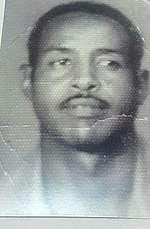
The Somali National Movement (SNM) was a 1980s–1990s rebel group. The SNM was organized in London, England, on April 6, 1981 by Hasan Adan Wadadid (Faarah Ainanshe) a former Somali diplomat and he stated that the group's purpose was to overthrow the Siaad Barre regime.[59] The SNM gathered its main base of support from members of the Isaaq clan, who formed and supported the movement in response to years of systematic discrimination by the Siaad Barre government.
Members of the Garhajis clan made up a significant portion of the leadership and soldiers of the SNM. Garhajis Commanders carried out many successful operations that led to the decisive victory of the group and to the downfall of the Siad Barre regime.
Such operations included the Birjeex raid led by Colonel Ibrahim Koodbuur ( Eidagale) and Operation Mandheera led by Mohamed Hashi Diriye lixle (Musa Abdallah) where they successfully freed hundreds of Isaaq political prisoners whose executions were imminent.[60]
Under the leadership of Abdirahman Ahmed Ali Tuur (Musa Arreh) the SNM carried out a successful invasion of Northern Somalia overthrowing the Communist regime and establishing the democratic state of Somaliland. Abdirahman was sworn in as Somaliland's first president.
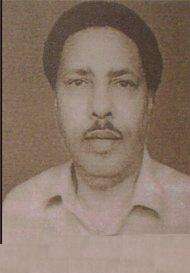
List of Garhajis SNM leaders:[61][62]
- Abdirahman Tuur
- Abdulkadir Koosaar
- Mohamed Hashi Lihle
- Ibrahim Koodbuur
- Mohamed Ali
- Haragwaafi
- Madah-diin
- Wiyilfurato
- Omar Aseyr
- Ahmed Mire
- Dhancade
- General Hassan Kayd
Eidagale
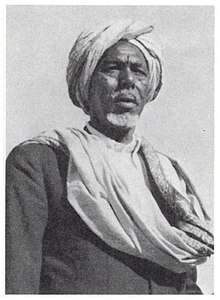
The Eidagale (Somali: Ciidagale/Ciidan Gale, which translates to "army joiner") are the traditional holders of the Isaaq Sultanate since the 18th century. The Isaaq Sultanate was established in the mid-18th century by Sultan Guled Abdi Eise of the Eidagale clan. His coronation took place after the victorious battle of Lafaruug in which he successfully led the Eidagale in battle and defeated the Absame tribes, permanently pushing them out of present-day Waqooyi Galbeed region. After witnessing his leadership skills, noble conduct and valiance, the Isaaq chiefs recognized him as their Grand Sultan. Guled's Sultanate predates the Habr Yunis Sultanate, which broke off from Eidagale tutelage several decades after the start of his rule. Sultan Guled ruled the Isaaq from the 1750s up until his death in the early 19th century, where he was succeeded by his eldest son Farah. Sultan Farah further expanded the influence of the Sultanate by establishing ties with various Muslim polities across the Gulf, particularly the Al-Qasimi family whom he regularly corresponded with in regard to military action against the British Navy who blockaded Berbera and threatening to cut off vital trade.[63]
For centuries, the tomb of saint Aw Barkhadle, which is located between Berbera and Hargeisa, was used by the Isaaq clans to settle disputes and to swear oaths of alliances under a holy relic attributed to Bilal Ibn Rabah. As traditional leaders of the Isaaq clans, the Eidagale placed themselves as mediators during the disputes.
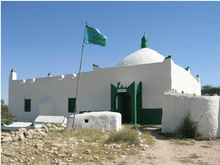
When any grave question arises affecting the interests of the Isaakh tribe in general. On a paper yet carefully preserved in the tomb, and bearing the sign-manual of Belat [Bilal], the slave of one the early khaleefehs, fresh oaths of lasting friendship and lasting alliances are made...In the season of 1846 this relic was brought to Berbera in charge of the Haber Gerhajis, and on it the rival tribes of Aial Ahmed and Aial Yunus swore to bury all animosity and live as brethren.[64]

The Eidagale were renowned for their equestrian skills, and their devastating raids extended between the coast and the interior.[65] According to Swayne, who traversed through Somaliland in the late 19th century, the Eidagale were amongst the clans most addicted to raiding:
The tribes near the northern coast most addicted to raiding appear to be the Jibril Abokor sub-tribe of the Habr Awal, the Mahamud Gerad Dolbahanta, and the Eidagalla, Habr Gerhajis.[66]
Apart from their equestrian skills, the Eidagale are also famed for their eloquence in traditional Somali poetry (gabay), producing many famous poets such as Abdi Gahayr, Xasan Tarabi, and Elmi Boodhari. Historically, the Eidagale were viewed as "the recognized experts in the composition of poetry" by their fellow Somali contemporaries:[67]
Among the tribes, the Eidagalla are the recognized experts in the composition of poetry. One individual poet of the Eidagalla may be no better than a good poet of another tribe, but the Eidagalla appear to have more poets than any other tribe. "if you had a hundred Eidagalla men here," Hersi Jama once told me, "And asked which of them could sing his own gabei ninety-five would be able to sing. The others would still be learning."[68]
For centuries, the Eidagale (along with their Habar Yunis kin) were influential stakeholders in the long-distance Somali caravan trade. Eidagale merchants procured various goods from the Somali Region in present-day Ethiopia, such as livestock, acacia gum, myrrh, ivory and ghee, which were subsequently exported to Southern Arabia. The Eidagale caravan merchants founded several inland trade entrepôts in the interior, which also includes the modern city of Hargeisa, founded in the 19th century as a caravan junction between Berbera and the Somali interior.[69][70][71]
Sultans of the Eidagale
| Name | Reign
From |
Reign
Till | ||
|---|---|---|---|---|
| 1 | Abdi Eisa ('Traditional Chief) | 1680 | 1750 | |
| 2 | Sultan Guled Abdi (First Sultan) | 1750 | 1808 | |
| 3 | Sultan Farah Sultan Guled | 1808 | 1845 | |
| 4 | Sultan Hassan Sultan Farah | 1845 | 1870 | |
| 5 | Sultan Diriye Sultan Hassan | 1870 | 1939 | |
| 6 | Sultan Abdilahi Sultan Diriye | 1939 | 1967 | |
| 7 | Sultan Rashid Sultan Abdilahi | 1967 | 1969 | |
| 8 | Sultan Abdulkadir Sultan Rashid | 1969 | 1975 | |
| 9 | Sultan Mohamed Sultan Abdikadir | 1975 |
Sultanate of the Habr Yunis
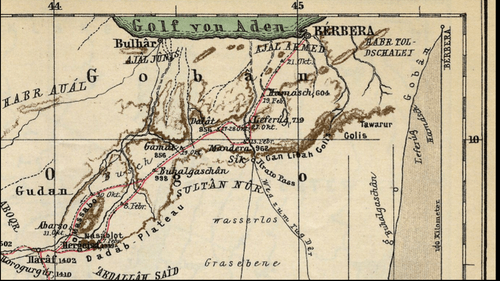
The Habr Yunis Sultanate was a Somali Kingdom that ruled parts of the Horn of Africa during the 18th and 19th centuries. The Kingdom's territory encompassed the lands settled by the Habr Yunis tribe of the Garhajis clan. The Habr Yunis Sultans received a tax in the form of an annual tribute of livestock from their subjects and they regularly taxed the trade caravans that went through their territory. Moreover, the sultanate had a significant standing army which was used to enforce the taxation, as well as to defend their realm.[72][73]
The first Habr Yunis chief to assume the title Sultan was Sugulleh Ainanshe of the Ismail Arrah clan, his father Ainanshe was a traditional chief. Sugulleh was succeeded by his son Diriyeh Sugule in the late 18th century. Sultan Diriyeh reigned for more than 50 years and was eventually succeeded by his grandson Hersi Aman. Hersi is most notable for expanding Habr Yunis territory in the Haud and for engaging the first Rer Sugulleh civil war which resulted in his death. Sultan Hersi's death caused a decade-long civil war when his nephew Nur was crowned Sultan and his great uncle Awad Sultan Deriyeh and eldest living son of sultan Deriyeh declared himself a rival sultan in 1881.The two Sultans were now at war with each other and divided the Kingdoms territory between themselves, with Nur being based in the Toyo plains and Awd establishing himself at Burao. In the 1890s Sultan Awad was killed in a battle which resulted in Sultan Nur facing no opposition and was the sole ruler of the Habr Yunis Sultanate up until he started the Dervish uprising, which resulted in his uncle Madar Hersi being crowned. The Habr Yunis were now divided into two factions: pro-Dervish and anti-Dervish, the former being ruled by Sultan Nur and the latter the newly crowned Sultan Madar. After Nur's death in the Dervish camp, the Habr Yunis elders crowned his son Dolal, and with the Dervish defeat none of his heirs succeeded him leaving Madar's descendants as the undisputed Sultans of the Habr Yunis.[74][75]
Sultans of the Habr Yunis
| Name | Reign
From |
Reign
Till | ||
|---|---|---|---|---|
| 1 | Ainasha Hersi (traditional chief) | |||
| 2 | Sultan Sugulleh Ainasha (first sultan) | |||
| 3 | Sultan Diriyeh Sultan Sugulleh Ainasha | |||
| 4 | Sultan Hersi Aman Sultan Diriyeh | |||
| 5 | Sultan Nur Ahmed Aman Sultan Diriyeh | |||
| 6 | Sultan Awad Sultan Diiriye | |||
| 7 | Sultan Dolal Sultan Nur | |||
| 8 | Sultan Madar Hersi Sultan cabdale | |||
| 9 | Sultan Ali Sultan Madar Hersi | |||
| 10 | Sultan Osman Sultan Ali Sultan Madar |
Clan tree
A summarized clan family tree of the major Garhajis subclan of Habar Yunis is presented below.[76][77]
- Sheikh Ishaaq Bin Ahmed (Sheikh Ishaaq)
- Habar Habuusheed
- Ahmed (Tol-Ja'lo)
- Muuse (Habr Je'lo)
- Ibrahiim (Sanbuur)
- Muhammad ('Ibraan)
- Habar Magaadle
- Abdirahman (Subeer Awal)
- Ayub
- Muhammad (Arap)
- Ismail (Garhajis)
- Said Ismail (Habar Yunis)
- Ali Said
- Arreh Said
- Ishaq Arreh
- Abdalle Ishaq
- Qaasin Ishaq
- Musa Arreh
- Hassan Musa,Ibrahim Musa,Damal Musa (Dir Roble)
- Ismail Arreh
- Sa'ad Yunis
- Musa Ismail
- Salah Musa (Turwa)
- Salah Musa
- Mohammed Musa (Urursuge)
- Yunis Musa
- Abdallah Ismail
- Idris (idrays)
- Musa Abdallah
- Omar Abdallah
- Hersi Osman
- Said Hersi
- Rer Warsama (Waraba)
- Rer Weid
- Abdi Hersi
- Ainanshe Hersi (The Ainanshe Hersi are the royal sub-clan of the Habr Yunis and the hereditary Sultanate is currently held by them.)[78][77]
- Sugulle Ainanshe
- Eise Ainanshe
- Wa’ays Ainanshe
- Suban Ainanshe
- Abdi Ainanshe
- Egal Ainanshe
- Omar Ainanshe
- Koshin Ainanshe
- Maygag Ainanshe
- Butiye Ainanshe
- Ahmed Ainanshe
- Farah Ainanshe
- Samaale Ainanshe
- Hersi Ainanshe
- Guled Ainanshe
- Gutale Ainanshe
- Liibaan Ainanshe
- Said Hersi
- Hersi Osman
- Ishaq Arreh
- Said Ismail (Habar Yunis)
- Habar Habuusheed
- Daud Ismail (Eidagale) (The Eidagale sub-clan are divided into the following sections)[76]
- Sheikh Ishaaq
- Ismail (Garhajis)
- Daud (Eidagale)
- Esa
- Bilal
- Mohamed (Guyobe)
- Ali Afweina
- Urkurag
- Musa
- Abokor
- Abdirahman
- Yunis (Rer Yunis)
- Abdulle
- Mohamed (Ba Delo)
- Ibrahim
- Kul
- Abdi
- Abokor
- Barre
- Ismail
- Hussein
- Mataan
- Hamud
- Roble
- Adan
- Burale
- Abane
- Muse
- Barre
- Ilgin
- Wais
- Abdille
- Damal
- Gobdon
- Deria
- Fatah
- Gabib
- Hode
- Esa
- Liban
- Hassan
- Warfa
- Guled
- Abdi
- Ainashe
- Adan
- Afweina
- Guled
- Yusuf
- Roble
- Jama
- Deria
- Egal
- Gatah
- Farah (Sultan Farah)
- Dualeh
- Abdi
- Ali
- Rageh
- Wais
- Habrwa
- Awid
- Mohamed
- Sugulle
- Amareh
- Mataan
- Daud (Eidagale)
- Ismail (Garhajis)
Notable people
- Abdikarim Mohamed Eid, CEO of Telesom, one of the largest Somali-owned telecommunications company and the first to implement mobile money (Zaad) in the Somali Peninsula
- Abdillahi Deria, 5th Grand Sultan of the Isaaq clan and anti-colonial figurehead
- Abdirahman Ahmed Ali Tuur, the first President of Somaliland and the last Somali National Movement(SNM) Chairman
- Abdirahman Mohamed Abdullahi, former Speaker of the House of Representatives of Somaliland and the current chairman of Wadani political party
- Abdullahi Qarshe, Somali musician, poet and playwright; known as the "father of Somali music"
- Ali Sugule, One of the greatest composer, poet and playwrighter of the Somali language
- Amina Moghe Hersi, prominent businesswoman and wealthiest Somali woman
- Awad Deria, 5th Sultan of the Habr Yunis clan
- Deria Hassan, 4th Grand Sultan of the Isaaq clan
- Elmi Boodhari, Poet known in the Somali world for his famous love poems
- Faysal Ali Warabe, chairman of UCID party (Justice and Development party of Somaliland)
- Fowsiyo Yusuf Haji Adan, former Foreign Minister of Somalia and MP in Federal Parliament
- Hassan Kayd, First African national to enter and graduate in the prestigious Sandhurst Military Academy
- Hersi Aman, 3rd Sultan of the Habr Yunis clan
- Hussein Arab Isse, formed Minister of Defence of Somalia and Deputy Prime Minister of Somalia from July 20, 2011 to November 4, 2012
- Hussein Mohammed Adam (Tanzania), foremost Somali intellectual and scholar who founded the Somali Studies International Association (SSIA)
- Jama Mohamed Ghalib, former Police Commissioner of the Somali Democratic Republic, Secretary of Interior, Minister of Labor and Social Affairs, Minister of Local Government and Rural Development, Minister of Transportation, and Minister of Interior
- Mahdi M. Gulaid, the current Deputy Prime Minister of Somalia
- Mohamed Ainanshe Guleid, former Major General in the Somali National Army and Vice president of the Somali Democratic Republic
- Mohamoud Ahmed Ali, widely considered the father of modern Somali education[79]
- Mohamed Mooge Liibaan, prominent Somali instrumentalist and vocalist
- Nur Ahmed Aman, 4th sultan of the Habr Yunis and one of the founders of the Somali Dervish movement
- Sharmarke Ali Saleh, 19th century tribal chief, business magnate and Governor of Zeila, Berbera, and Tadjoura
- Yusuf Dirir Abdi, Diplomat and member of the Somali Salvation Democratic Front
References
- "I.M Lewis, A pastoral democracy, p. 10".
- A General survey of the Somaliland protectorate 1944-1950, p.122, table 18
- "Africa, Volumes 29-30, Oxford University Press, 1959, p.276".
- "Welcome Home to Nothing: Refugees Repatriate to a Forgotten Somaliland, p.17" (PDF).
- "Ethnographic Survey of Africa , p.24".
- "I.M Lewis, Blood and Bone, p. 108".
- The Journal of the Royal Geographical Society, Volume 19, p. 61, 1848
- "Violent deeds live on: landmines in Somalia and Somaliland, p. 63". |
- "I.M Lewis : peoples of the Horn of Afrcia". |
- I.M. Lewis, A Modern History of the Somali, fourth edition (Oxford: James Currey, 2002), pp. 31 & 42
- "مخطوطات > بهجة الزمان > الصفحة رقم 16". makhtota.ksu.edu.sa. Retrieved 2017-08-24.
- "The Journal of the Royal Geographical Society Volume 19 p.61".
- Proceedings of the Royal Geographical Society and Monthly Record of Geography 1885, Volume 7, p.627
- The Unknown Horn of Africa: An Exploration From Berbera to the Leopard River, by Frank Linsly james, p.67
- Outing: Sport, Adventure, Travel, Fiction, Volume 39
- Historical Record of the 14th King Hussars, By Colonel Henry Blackburne Hamilton
- "Churchill and the Mad Mullah of Somaliland, p. 87".
- First footseps in to Africa, by Richard Burton, p.265
- First footseps in to Africa, by Richard Burton, p.16-p.30
- Sun, sand and Somals; leaves from the note-book of a district commissioner in British Somaliland, by Rayne Henry. p.15-16
- Ethiopia: the Era of the Princes: The Challenge of Islam and Re-unification of the Christian Empire, 1769-1855. p.18
- Transactions of the Bombay Geographical Society, Volume 8, p.185 By Bombay Geographical Society
- Burton, First Footsteps, pp. 176 and note
- G. A. Haggenmacher's Reise Im Somali-Lande, 1874: Mit Einer Originalkarte by G.A.
- The Unknown Horn of Africa, by James, F. L. (Frank Linsly) 1851-1890; Thrupp, James Godfrey. p. 264.
- Proceedings of the XVth International Conference of Ethiopian Studies Hamburg (2003), p. 215.
- "Dictionary of African Biography. 1St- Ed.; 1970 , p.171".
- "Churchill and the Mad Mullah of Somaliland ,p.149".
- The Mad Mullah of Somaliland, Douglas Jardine, p.197
- "The Parliamentary Debates (official Report) House of Commons. 4th session of the 28th Parliament through the 1st session of the 48th Parliament, 1914".
- Foreign Department-External-B, August 1899, N. 33-234, NAI, New Delhi, Inclosure 2 in No. 1. And inclosure 3 in No. 1.
- F.O.78/5031,Sayyid Mohamad To The Aidagalla, Enclosed Sadler To Salisbury. 69, 20 August 1899.
- Official history of the operations in Somaliland, 1901–04 by Great Britain. War Office. General Staff Published 1907.p.56
- Official History of the Operations in Somaliland. 1901–1904 Vol. I p. 54
- Les Çomâlis. Ferrand, Gabriel, 1903. p. 268.
- Caroselli, op. cit. 78-9.
- Il Benadir, Vico Mantegazza. 1908. pp. 323-324.
- Il Benadir by Pizza, Giuseppe. 1913
- Ferro e fuoco in Somalia, con lettera introduttiva di Emilio de Bono. Francesco Saverio Caroselli. pp.105-106
- British SomaliLand by Ralph E Drake Brockman .1012. p. 82
- Taleh by W. A. MacFadyen, The Geographical Journal Vol. 78, No. 2 (Aug., 1931), pp. 125–128.
- Official History of the Operation Volume 1, p.49
- The Mad Mullah of Somaliland , p.252-p.258
- "The "Mad Mullah" and Northern Somalia,by Robert L.Hess" (PDF).
- "King's College London, King's collection: Ismay's summary as Intelligence Officer (1916-1918) of Mohammed Abdullah Hassan".
- The scramble in the Horn of Africa:History of Somalia (1827-1877), By Mohamed Osman Omar, p.453.
- "Ferro e fuoco in Somalia".
- "Churchill and the Mad Mullah of Somaliland, p. 209".
- "Imperialismo e resistenza in corno d'Africa: Mohammed Abdullah Hassan, P.305".
- "The warrior mullah: the Horn aflame, 1892-1920, by R.W Beachey, p.153".
- Colonial Office, April 11, 1922
- Public Record Office file WO 106/272 (Digest of History of Somaliland Camel Company KAR)
- Public Record Office file CO 1069/13 Part 1, by the first officer commanding "B" (Nyasaland) Company SCC).
- The King's African Rifles by H. Moyse-Bartlett
- Correspondence between Governor of British Somaliland and Secretary of State for the Colonies. Colonial Office, 26th March, 1922.
- Correspondence between Governor of British Somaliland and Secretary of State for the Colonies. Colonial Office, 28th February, 1922
- 1922 Commons sitting. HC Deb 14 March 1922 vol 151 cc1953-4
- "Dictionary of battles and sieges P-Z, p.991".
- Helen Chapin Metz, Somalia: a country study, Volume 550, Issues 86-993, (The Division: 1993), p.xxviii.
- MGoth (13 January 2018). "The Rebirth of Somaliland;Operation Birjeex (SNM Rescue Unit)-Part 7".
- Forberg, Ekkehard; Terlinden, Ulf (13 April 1999). "Small Arms in Somaliland: Their Role and Diffusion". BITS – via Google Books.
- Horn of Africa, Volume 13, Issue 2
- http://t-3abersbeelculture.blogspot.com/2014/03/blog-post_14.html?m=1
- "The Journal of the Royal Geographical Society Volume 19 p.61-62".
- Osman-Omar, Mohamed (2001). The scramble in the Horn of Africa: history of Somalia. Somali Publications. p. 63.
- Carlos-Swayne, Harald (1900). Seventeen Trips Through Somaliland and a Visit to Abyssinia. p. 40.
- Diriye, p. 75.
- Laurance, Margaret. A tree for poverty: Somali poetry and prose. McMaster University Library Press. p. 27.
- Hunter, Frederick (1877). An Account of the British Settlement of Aden in Arabia. Cengage Gale. p. 41.
- Journal of African Languages. University of Michigan Press. 1963. p. 27.
- Carlos-Swayne, Harald (1900). Seventeen Trips Through Somaliland and a Visit to Abyssinia. p. 96.
- The Journal of The anthropological institute of Great Britain and Ireland| Vol.21 p. 161
- Journal of the East Africa Natural History Society: Official Publication of the Coryndon Memorial Museum Vol.17 p. 76
- Cosmos: communicazioni sui progressi recenti e notevoli della geografia e delle scienze affini di Guido Cora p. 201
- British Somaliland by Drake Borckmen, p. 79 - 82, 1912
- "A grammar of the Somali Language, p.140".
- A general survey of the Somaliland Protectorate 1944-1950, p147
- "A grammar of the Somali language, p. 141".
- "Somalia: Education in Transition".
